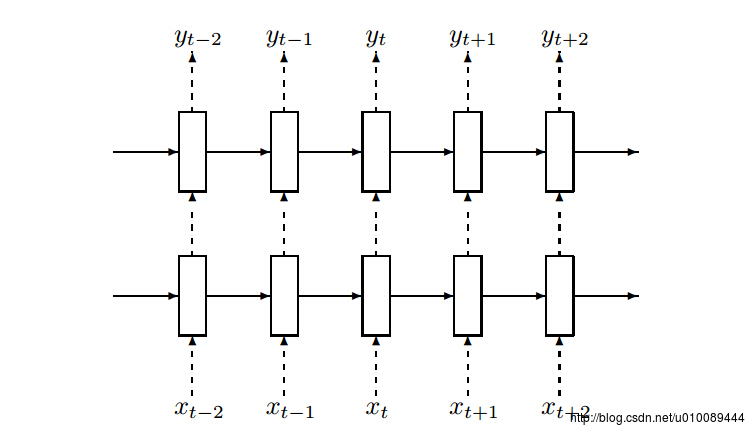Tensorflow - Tutorial : 利用 RNN/LSTM 进行手写数字识别
Posted Joe-Han
tags:
篇首语:本文由小常识网(cha138.com)小编为大家整理,主要介绍了Tensorflow - Tutorial : 利用 RNN/LSTM 进行手写数字识别相关的知识,希望对你有一定的参考价值。
1. 常用类
class tf.contrib.rnn.BasicLSTMCell
BasicLSTMCell 是最简单的一个LSTM类,没有实现clipping,projection layer,peep-hole等一些LSTM的高级变种,仅作为一个基本的basicline结构存在,如果要使用这些高级变种,需用class tf.contrib.rnn.LSTMCell这个类。
使用方式:
lstm = rnn.BasicLSTMCell(lstm_size, forget_bias=1.0, state_is_tuple=True)Args:
num_units: int, The number of units in the LSTM cell.
forget_bias: float, The bias added to forget gates.
state_is_tuple: If True, accepted and returned states are 2-tuples of the c_state and m_state. If False, they are concatenated along the column axis. The latter behavior will soon be deprecated.
activation: Activation function of the inner states.
说明:
- num_units 是指一个Cell中神经元的个数,并不是循环层的Cell个数。这里有人可能会疑问:循环层的Cell数目怎么表示?答案是通过如下代码中的 time_step_size确定(X_split 中划分出的arrays数量为循环层的Cell个数):
X_split = tf.split(XR, time_step_size, 0)- 在任意时刻
t
,LSTM Cell会产生两个内部状态
ct 和 ht (关于RNN与LSTM的介绍可参考:循环神经网络与LSTM)。当state_is_tuple=True时,上面讲到的状态 ct 和 ht 就是分开记录,放在一个二元tuple中返回,如果这个参数没有设定或设置成False,两个状态就按列连接起来返回。官方说这种形式马上就要被deprecated了,所有我们在使用LSTM的时候要加上state_is_tuple=True。
class tf.contrib.rnn.DropoutWrapper
RNN中的dropout和cnn不同,在RNN中,时间序列方向不进行dropout,也就是说从t-1时刻的状态传递到t时刻进行计算时,这个中间不进行memory的dropout;如下图所示,Dropout仅应用于虚线方向的输入,即仅针对于上一层的输出做Dropout。

因此,我们在代码中定义完Cell之后,在Cell外部包裹上dropout,这个类叫DropoutWrapper,这样我们的Cell就有了dropout功能!
lstm = tf.nn.rnn_cell.DropoutWrapper(lstm, output_keep_prob=keep_prob)Args:
cell: an RNNCell, a projection to output_size is added to it.
input_keep_prob: unit Tensor or float between 0 and 1, input keep probability; if it is float and 1, no input dropout will be added.
output_keep_prob: unit Tensor or float between 0 and 1, output keep probability; if it is float and 1, no output dropout will be added.
seed: (optional) integer, the randomness seed.
class tf.contrib.rnn.MultiRNNCell
如果希望整个网络的层数更多(例如上图表示一个两层的RNN,第一层Cell的output还要作为下一层Cell的输入),应该堆叠多个LSTM Cell,tensorflow给我们提供了MultiRNNCell,因此堆叠多层网络只生成这个类即可:
lstm = tf.nn.rnn_cell.MultiRNNCell([lstm] * num_layers, state_is_tuple=True)2. 代码
MNIST数据集的格式与数据预处理代码 input_data.py的讲解请参考 :Tutorial (2)
# -*- coding: utf-8 -*-
import tensorflow as tf
from tensorflow.contrib import rnn
import numpy as np
import input_data
# configuration
# O * W + b -> 10 labels for each image, O[? 28], W[28 10], B[10]
# ^ (O: output 28 vec from 28 vec input)
# |
# +-+ +-+ +--+
# |1|->|2|-> ... |28| time_step_size = 28
# +-+ +-+ +--+
# ^ ^ ... ^
# | | |
# img1:[28] [28] ... [28]
# img2:[28] [28] ... [28]
# img3:[28] [28] ... [28]
# ...
# img128 or img256 (batch_size or test_size 256)
# each input size = input_vec_size=lstm_size=28
# configuration variables
input_vec_size = lstm_size = 28 # 输入向量的维度
time_step_size = 28 # 循环层长度
batch_size = 128
test_size = 256
def init_weights(shape):
return tf.Variable(tf.random_normal(shape, stddev=0.01))
def model(X, W, B, lstm_size):
# X, input shape: (batch_size, time_step_size, input_vec_size)
# XT shape: (time_step_size, batch_size, input_vec_size)
XT = tf.transpose(X, [1, 0, 2]) # permute time_step_size and batch_size,[28, 128, 28]
# XR shape: (time_step_size * batch_size, input_vec_size)
XR = tf.reshape(XT, [-1, lstm_size]) # each row has input for each lstm cell (lstm_size=input_vec_size)
# Each array shape: (batch_size, input_vec_size)
X_split = tf.split(XR, time_step_size, 0) # split them to time_step_size (28 arrays),shape = [(128, 28),(128, 28)...]
# Make lstm with lstm_size (each input vector size). num_units=lstm_size; forget_bias=1.0
lstm = rnn.BasicLSTMCell(lstm_size, forget_bias=1.0, state_is_tuple=True)
# Get lstm cell output, time_step_size (28) arrays with lstm_size output: (batch_size, lstm_size)
# rnn..static_rnn()的输出对应于每一个timestep,如果只关心最后一步的输出,取outputs[-1]即可
outputs, _states = rnn.static_rnn(lstm, X_split, dtype=tf.float32) # 时间序列上每个Cell的输出:[... shape=(128, 28)..]
# Linear activation
# Get the last output
return tf.matmul(outputs[-1], W) + B, lstm.state_size # State size to initialize the stat
mnist = input_data.read_data_sets("MNIST_data/", one_hot=True) # 读取数据
# mnist.train.images是一个55000 * 784维的矩阵, mnist.train.labels是一个55000 * 10维的矩阵
trX, trY, teX, teY = mnist.train.images, mnist.train.labels, mnist.test.images, mnist.test.labels
# 将每张图用一个28x28的矩阵表示,(55000,28,28,1)
trX = trX.reshape(-1, 28, 28)
teX = teX.reshape(-1, 28, 28)
X = tf.placeholder("float", [None, 28, 28])
Y = tf.placeholder("float", [None, 10])
# get lstm_size and output 10 labels
W = init_weights([lstm_size, 10]) # 输出层权重矩阵28×10
B = init_weights([10]) # 输出层bais
py_x, state_size = model(X, W, B, lstm_size)
cost = tf.reduce_mean(tf.nn.softmax_cross_entropy_with_logits(logits=py_x, labels=Y))
train_op = tf.train.RMSPropOptimizer(0.001, 0.9).minimize(cost)
predict_op = tf.argmax(py_x, 1)
session_conf = tf.ConfigProto()
session_conf.gpu_options.allow_growth = True
# Launch the graph in a session
with tf.Session(config=session_conf) as sess:
# you need to initialize all variables
tf.global_variables_initializer().run()
for i in range(100):
for start, end in zip(range(0, len(trX), batch_size), range(batch_size, len(trX)+1, batch_size)):
sess.run(train_op, feed_dict={X: trX[start:end], Y: trY[start:end]})
test_indices = np.arange(len(teX)) # Get A Test Batch
np.random.shuffle(test_indices)
test_indices = test_indices[0:test_size]
print(i, np.mean(np.argmax(teY[test_indices], axis=1) ==
sess.run(predict_op, feed_dict={X: teX[test_indices]})))
3. 参考资料
- https://medium.com/@erikhallstrm/hello-world-rnn-83cd7105b767
- http://www.cnblogs.com/wuzhitj/p/6434171.html
- http://blog.csdn.net/mydear_11000/article/details/52414342
以上是关于Tensorflow - Tutorial : 利用 RNN/LSTM 进行手写数字识别的主要内容,如果未能解决你的问题,请参考以下文章